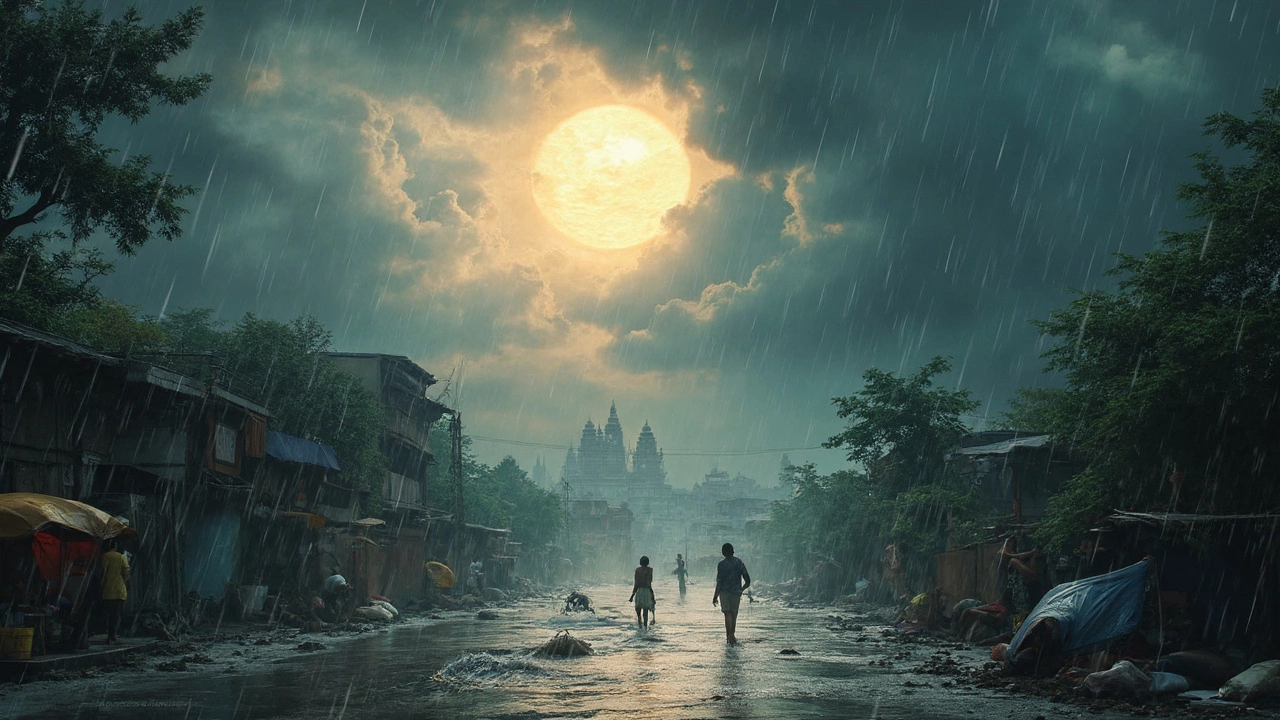Did you know that in 2024, Earth is going through some wild changes? Yep, from severe storms to freaky heatwaves, our climate's throwing pretty unexpected fits right now. We’re not just talking about a few extra hot days either—weather patterns have been acting up all around the globe. It's like Mother Nature's had enough, and oh boy, is she letting us know!
What’s more surprising? The biodiversity. Yup, some species are packing up and leaving—for good. Experts say biodiversity loss isn’t slowing down, making it clear we need to step up on conservation. And while you're sipping your coffee, forests are being chopped down at alarming rates, leading to more than just the obvious environmental chaos.
But it’s not all doom and gloom. The renewable energy scene is buzzing with action and innovation. Solar panels, wind turbines, they’re popping up everywhere! These could be our big ticket to balancing out carbon emissions. So, what’s happening with the planet, and what can we actually do about it? Stick around as we break it all down.
- Changing Climate Patterns
- Biodiversity Loss
- Global Pollution Crisis
- Renewable Energy Trends
- Deforestation Impact
- Sustainable Community Practices
Changing Climate Patterns
If you've needed a reminder that the climate's flipping out, 2024 has been it! Seriously, whether you live in New York or New Delhi, chances are you've noticed some of these drastic shifts. Earth 2024 is experiencing changes that are hard to ignore.
Global temperatures are rising faster than ever, leading to record-breaking heatwaves. And let's not forget the polar regions, which are warming up even quicker. Arctic ice melt is affecting ocean currents, which, in turn, messes with the weather patterns all over the planet. More heat means more water evaporating into the atmosphere, feeding those crazy storms and hurricanes.
Climate change doesn’t just mean hotter weather, though. It’s like flipping Mother Nature’s mood swings to extreme. Areas prone to drought are seeing longer dry spells while others are getting drenched more than ever. This has direct implications for agriculture, water resources, and just everyday life.
Unpredictable weather also means farmers have a tough time. Growing seasons are shifting, and some crops just can't hack it anymore. This affects food availability and prices, hitting different parts of the world in unique ways.
There’s major focus on cutting carbon emissions now, with renewable energy sources like wind and solar edging their way into the spotlight. However, it’s a race against time, needing global coordination and fast implementation so we can keep our weather in check and protect those gorgeous, warming poles.
What about our good ol' oceans? Climate change is playing havoc there too. Warmer waters mean marine ecosystems are changing, sometimes not for the better. Coral bleaching events have become more frequent, and that’s bad news for marine life depending on these reefs. A healthier ocean could help absorb more CO2, so it's vital to keep a close eye on this area.
It's all connected, isn't it? Knowing what’s going on and staying informed can help us make small adjustments in our lives that add up to broader changes. It's up to all of us to make a difference, one step at a time.
Biodiversity Loss
So, let's dive into what's really going on with biodiversity loss. It’s kinda like when you look around and notice fewer animals and plants than there used to be. This isn’t just about losing a few rare species. We’re talking about entire ecosystems struggling to keep up.
For starters, habitats are disappearing faster than ever. Deforestation is a biggie, and it’s not just happening somewhere far away—it affects us all. Forests act as the lungs of the Earth, and losing them means less oxygen and more carbon dioxide. The Amazon, for instance, is being chopped down at an alarming rate, which affects not only the species living there but also has ripple effects on the global climate.
And it's not just forests. Oceans are under threat too. Coral reefs, known as the rainforests of the sea, are bleaching and dying due to rising water temperatures. This is pretty serious, as they provide habitats to millions of marine species.
Wanna hear something wild? About one million animal and plant species are at risk of extinction, many within decades. This isn’t just bad for them—it lowers biodiversity, making ecosystems less resilient to changes. Imagine trying to balance a tower of blocks; take away a few and the whole thing might topple.
So, what can we do about it? Here are a few practical steps:
- Support Conservation Efforts: Whether it’s donating to reputable conservation organizations or volunteering, every little bit helps.
- Go Green: Opt for products that are sustainably sourced. When shopping for paper, for example, choose recycled options.
- Spread Awareness: Talk to your friends and family. Education is one of the most powerful tools we have.
To sum it up, biodiversity is crucial for keeping the planet ticking, and every effort to protect it counts.
Global Pollution Crisis
We're knee-deep in a serious global pollution crisis right now. From air to water, pollution is pretty much everywhere you look. Take this: air quality in major cities has reached unhealthy levels, with smoggy skies becoming the norm in places like Delhi and Los Angeles. Particulate matter, tiny particles in the air that are harmful to breathe, is a big culprit here.
Then there's plastic. Our oceans are practically drowning in the stuff, with an estimated 8 million tons dumped annually. Imagine this: that's like tossing a garbage truck full of plastic into the ocean every minute. This isn't just bad news for the fish. It’s bad for us too, as these plastics eventually work their way up the food chain.
Let’s not overlook water pollution. Industries are still discharging toxic waste into rivers, affecting both wildlife and the communities relying on these water sources. Access to clean, safe water is becoming a daunting challenge in some regions. Here’s something you might not know: developing countries bear the brunt of this issue because they often lack effective treatment infrastructure.
- Air pollution: Kills an estimated 7 million people worldwide each year.
- Plastic in oceans: It's projected that by 2050, there'll be more plastic than fish in the seas.
- Water contamination: Over 80% of the world's wastewater flows back into the environment untreated.
Solutions? They’re there, and they're doable. Cutting down on single-use plastics, opting for sustainable goods, supporting clean energy—these small steps can add up. It's high time we take action and be part of the solution rather than the problem. After all, our Earth needs a bit of love, don’t you think?

Renewable Energy Trends
Okay, let’s talk about the buzz around renewable energy. In 2024, it’s skyrocketing, and everyone’s getting on board! Solar and wind power are leading the pack, turning rooftops and open fields into energy hubs. It’s crazy how fast solar panels are getting cheaper and more efficient. Thanks to tech advancements, these shiny panels aren’t just for tech geeks anymore; they’re everywhere!
Did you know wind farms are getting bigger and better too? Offshore wind power’s hitting new records, especially in places like Europe and the US. These big spinning turbines are making a serious dent in reducing greenhouse gas emissions.
Here’s a cool factoid—in 2024, global investment in renewables hit a record high. More than ever, folks are recognizing the urgency to switch gears and decrease their carbon footprints. Check out some of the big players:
- China: Still leading the charge with massive solar parks.
- USA: All about wind energy, especially offshore.
- India: Rapid solar expansion, kicking coal to the curb.
Governments and businesses aren’t just sitting back. Policies and incentives are pushing renewables, making it easier for individuals and companies to jump in. Awesome initiatives like community solar projects are popping up, bringing people together to share clean energy benefits.
Sure, challenges exist. Grid stability and storage tech need catching up, but experts are optimistic. So, reality check—if you’re thinking about hopping on the renewable bandwagon for your home, now’s a great time!
Deforestation Impact
Alright, let's talk about trees—or rather, the lack of them. In 2024, deforestation is a major issue that’s not just sending the environment into a tailspin but also affecting millions of people. Deforestation is essentially our forests disappearing faster than we can say 'replant,' and it’s mainly driven by agriculture, logging, and infrastructure expansion.
Every minute, forests the size of about 27 soccer fields are cut down. That's huge, right? This leads to a bunch of problems. For one, forests are like the lungs of our planet, absorbing carbon dioxide and providing oxygen. Without them, we’re staring at increased climate change, with CO2 levels skyrocketing.
But let's not just think about CO2. Forests are packed with biodiversity, home to millions of species. As deforestation accelerates, countless species lose their habitats, pushing them closer to extinction. This messes with ecosystems and even affects human communities that rely on these forests for resources and cultural reasons.
So, how bad is it really? Check out this quick snapshot:
| Factor | Impact (2024) |
|---|---|
| Lost Forest Area | 13 million hectares/year |
| Carbon Release | Approximately 12% of annual global emissions |
| Biodiversity Loss | Thousands of species at risk |
Thankfully, all isn’t lost! There's a push towards sustainable forestry practices, conservation efforts, and reforestation projects. It's simple actions like supporting products with certified sustainable labels and reducing paper waste that can make a big difference. Plus, advocating for better policies helps keep forests around for the future.
Sustainable Community Practices
Ever wondered what cool things communities are doing to help the planet? Well, in 2024, there's a bunch of them stepping up and setting examples. They're not just waiting around for big companies or governments to change things. Nope, they're making changes themselves, right in their neighborhoods.
Many towns and cities are embracing sustainability by kicking off projects that focus on local solutions. Ever hear of community gardens? These are popping up everywhere! They’re a fantastic way for people to grow fresh produce and learn about gardening together. It's not just about fruits and veggies, though—these gardens help cut down on the pollution from transporting food all around the globe. Neat, huh?
Another thing taking off is local renewable energy setups. Imagine this: rooftops filled with solar panels powering homes. That's not future talk anymore. Many communities have jumped on this bandwagon, signing up for local solar initiatives. It’s like sharing energy with your neighbors rather than relying solely on huge power plants.
There’s also a big push for reducing waste. Remember those single-use plastics everyone talks about? Communities are running campaigns to swap them out for reusable options—like cloth bags and bamboo utensils. Some places have even set up repair cafes where folks can learn to fix broken items instead of tossing them out, cutting down on waste.
To show just how impactful these practices are, check this out:
| Practice | Impact |
|---|---|
| Community Gardens | Reduces food miles, boosts biodiversity |
| Local Renewable Energy | Lowers carbon emissions, cuts costs |
| Waste Reduction Campaigns | Minimizes landfill waste, conserves resources |
So, why wait? There's plenty of ways to pitch in and make a difference where you live. Whether it's through environmental initiatives, joining a recycling program, or starting your own little garden patch—every small step counts!
